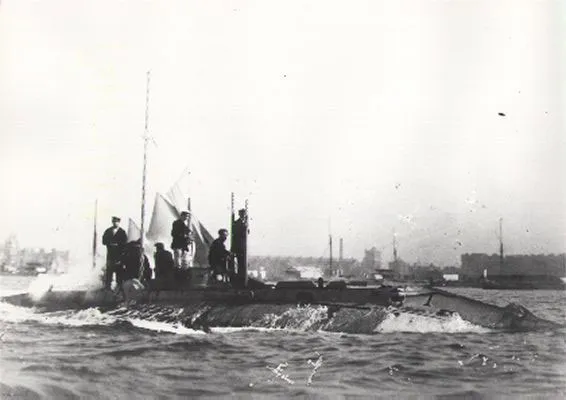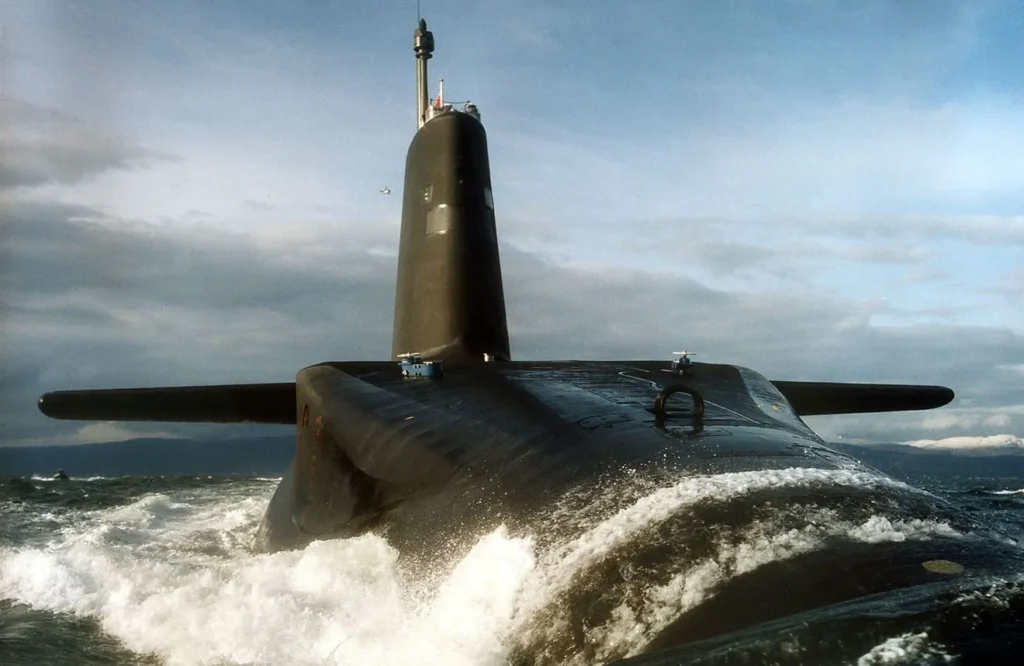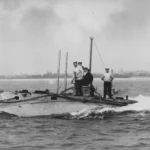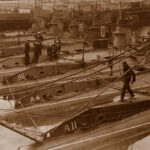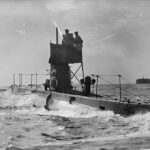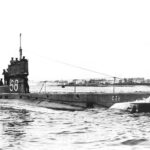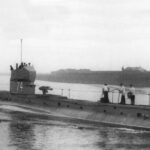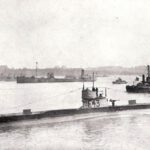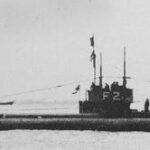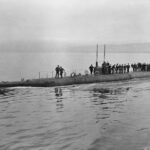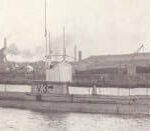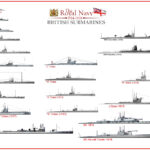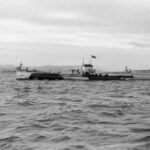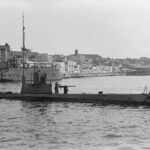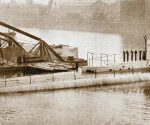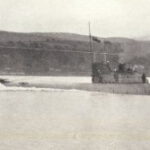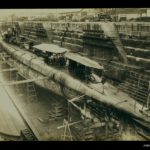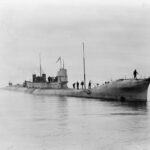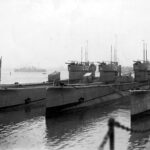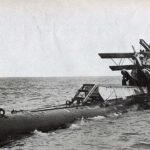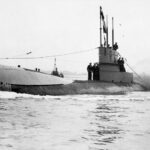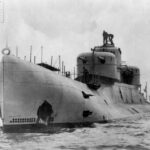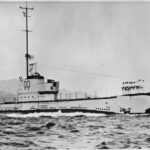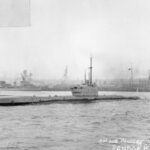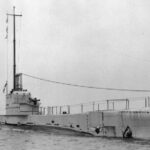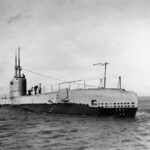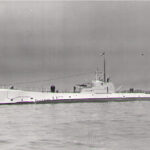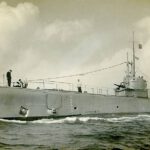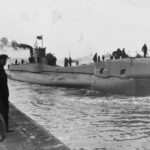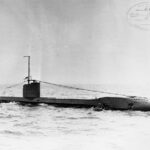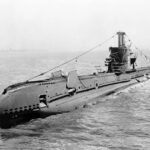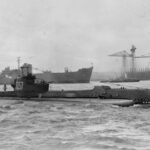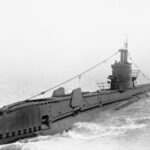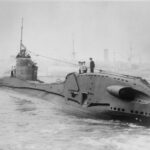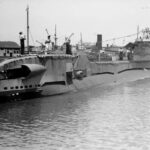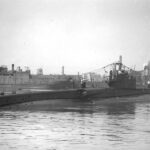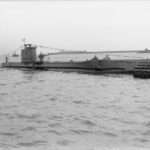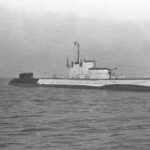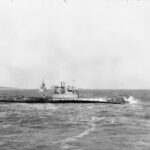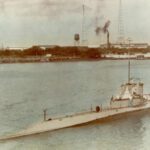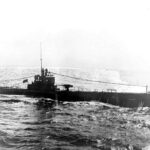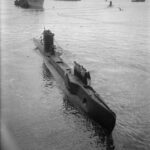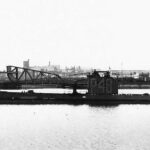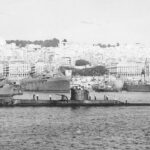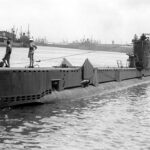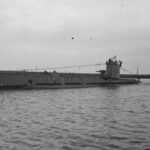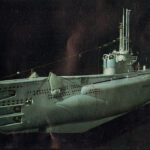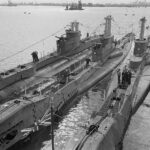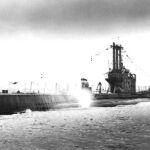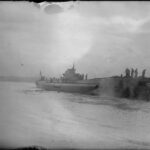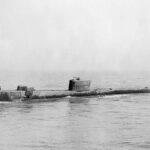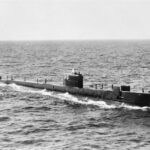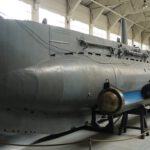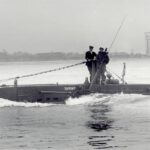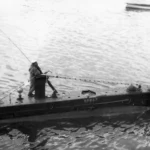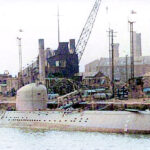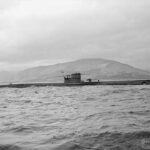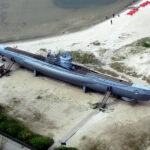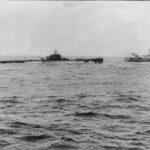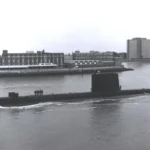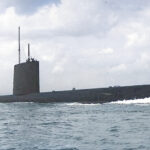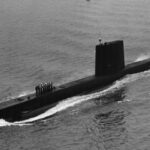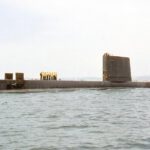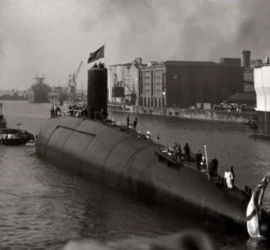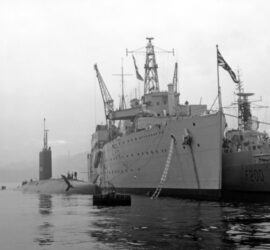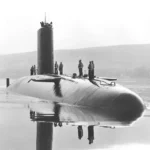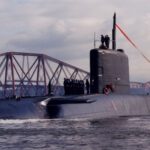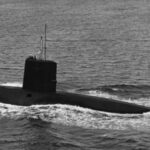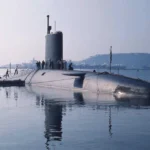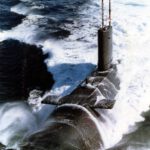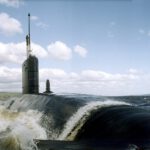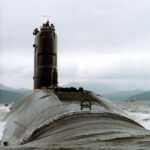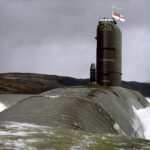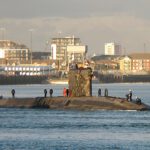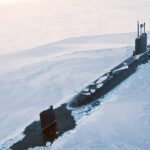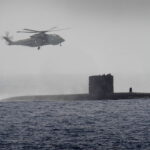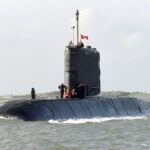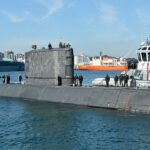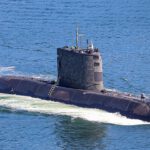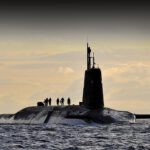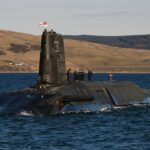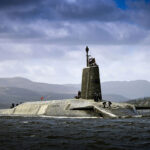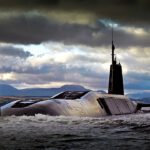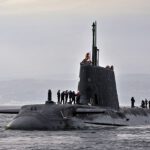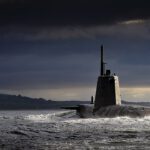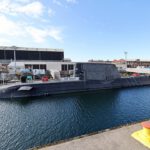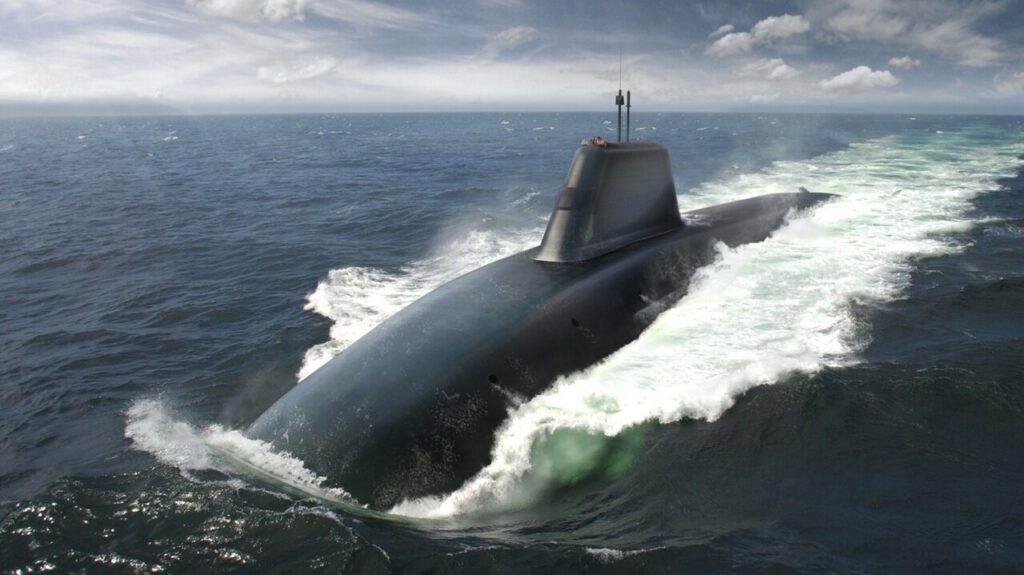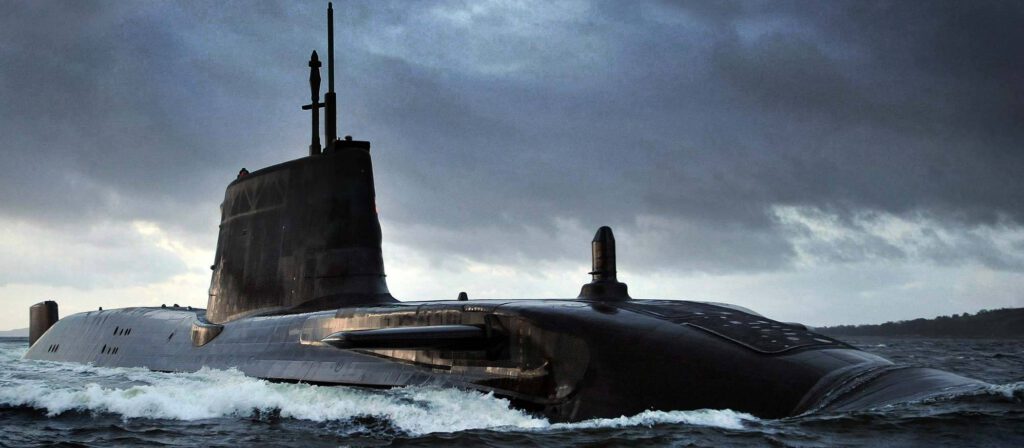
The Royal Navy Submarine Service is one of the five fighting arms of the Royal Navy. It is sometimes known as the Silent Service (Motto “we come unseen”). The Royal Navy’s Submarine Service began in 1901 with the launch of the first modern submarine HMS Holland 1. This modern submarine is credited to John Phillip Holland, and became a reality near the end of the 19th century. Holland was the first person to combine an electric motor, an electric battery, and an internal combustion engine in a completely modern submarine. Up until this time, the Royal Navy had made it clear that submarine development was not a priority. With this technological advancement, however, the Admiralty could not ignore submarines any longer. The Royal Navy ordered five Hollands to test them. The Admiralty had previously considered submarine warfare to be underhanded and “un-English.” But watching the Hollands sink four warships in a test exercise convinced the Admiralty of their effectiveness. Submarines were developed starting with the Hollands and continuing through A to D classes. The final D-class submarines had decking and deck guns.
Late in World War I, the Royal Navy introduced the large K-class submarines. In order to be fast enough to operate alongside the battlefleet, they used steam propulsion while surfaced. At the start of World War II, the Royal Navy had 60 submarines with another nine under construction. In the Mediterranean (during the Siege of Malta), British U-class submarines began operations against Italy as early as January 1941. Larger submarines began operations in 1940, but after 50% losses per mission, they were withdrawn. Until U-class vessels could be made available in numbers, British T-class submarines were used. The submarine force was cut back after the end of the war.
The first British nuclear-powered submarine Dreadnought was launched in 1960, based around a U.S.-built nuclear reactor. The Resolution class ballistic missile submarines (SSBNs) were introduced and were later replaced by the Vanguard class submarines and the Trident missile system from 1994. HMS Conqueror made history in 1982 during the Falklands War when she became the first nuclear-powered submarine to sink a surface ship, the General Belgrano.
At the end of the Cold War in 1989 the fleet consists of 30 submarines, which were grouped into four squadrons (First, Second, Third, and Tenth (SSBN)) at three bases. During Operation Veritas, the attack on Al-Qaeda and Taliban forces following the September 11 attacks in the United States,Trafalgar was the first Royal Navy submarine to launch Tomahawk cruise missiles against targets in Afghanistan.
Today The Submarine Service consists of two classes of Fleet submarines and one class of Ballistic Missile submarines. There are seven fleet submarines on active duty – five Trafalgar class submarines and two Astute class submarines. They are all nuclear submarines and are classified as SSNs. The Fleet submarines are sometimes referred to as attack or hunter-killer vessels.
Pre-First World War
In the early 20th century, many Royal Navy admirals dismissed submarines as worthless and dishonorable compared to traditional surface ships. Submariners were often looked down upon by their surface fleet counterparts. However, some forward-thinking leaders, like Admiral Sir John Fisher, recognized submarines’ potential as powerful weapons. Despite resistance, Britain began building submarines before World War I.
Early submariners, including Lieutenant Forster D. Arnold-Forster, were sometimes motivated more by opportunity and pay than enthusiasm. The submariners proved their value through exercises demonstrating their ability to stealthily attack battleships. Service in these early submarines was dangerous, with a high casualty rate due to accidents and mishaps. By 1914, 90 ratings and 18 officers had died in submarine service.
Winston Churchill later praised submariners for their devotion and bravery in facing such perilous conditions.
Class | No. build | Commissioned | Notes |
Holland class | 5 | 1903 | The Holland class were the first submarines built for the Royal Navy. |
A class | 13 | 1903 | The A-class was the Royal Navy's first class of British-designed submarines. |
B class | 11 | 1905 | The B-class boats were similar in design to the A-class and intended for coastal patrol work. |
C class | 38 | 1906 | The C-class submarines were the last class of petrol engined submarines of the Royal Navy |
Holland class (5):
Holland 1 – Holland 5
A class (13):
HMS A1 – HMS A13
B class (11):
HMS B1 – HMS B11
C class (38):
HMS C1 – HMS C38
First World War
t the outbreak of World War I, battleship admirals underestimated submarines, seeing them as limited to defensive roles near home ports due to their small size, limited range, and weak firepower. However, British submarines quickly proved their worth with daring operations in areas like the Baltic and the Dardanelles, disrupting enemy trade and warships. Lieutenant Norman Holbrook famously earned the Victoria Cross for sinking a Turkish battleship with his aging submarine B11, despite harsh and toxic conditions onboard.
Like the Germans with their U-boats in the Atlantic, the British used submarines to try to break the stalemate on the Western Front but fell short of the strategic breakthrough they hoped for. Nevertheless, by war’s end, submarines had made such a significant impact that they sparked widespread fear and calls in the 1920s to ban them entirely, largely due to the Germans’ aggressive unrestricted submarine warfare.
Class | No. build | Commissioned | Notes |
D class | 8 | 1909 - 1912 | Build 8, Lost 4. The D-class submarine was the first class fitted with wireless transmitters. |
E class | 58 | 1913 - 1916 | The E-class submarines started out as improved versions of the D-class submarine. |
F class | 3 | 1915 - 1916 | During World War I, the F-class submarines were primarily used for coastal defence. |
S class | 3 | 1914 - 1915 | The S class boats were an experimental design for the Royal Navy. |
V class | 4 | 1915 - 1916 | Four V-class submarines were built. |
W class | 4 | 1914 - 1915 | The W-class submarines were built for the Royal Navy as experimental boats. |
G class | 14 | 1915 - 1917 | The G-class were a series of diesel-electric submarines for operations in the North Sea. |
H class | 42 | 1915 - 1919 | The H-class submarines were created to attack German Sumarines in Britisch waters. |
Nautilus class | 1 | 1917 | HMS Nautilus was the largest submarine built at the time. She was also the first with a name. |
Swordfish class | 1 | 1916 | HMS Swordfish was an experimental submarine capable of 20 knots on the surface. |
J class | 7 | 1915 - 1917 | Response to fast German submarines to operate alongside surface fleets. |
K class | 17 | 1917 | The K-class submarines were a class of steam-propelled submarines designed in 1913. |
L class | 27 | 1917 - 1919 | The L-class submarine was originally planned as an improved version of the E-class. |
M class | 3 | 1917 - 1919 | The M-class submarines were a class of diesel-electric submarines built during World War I. |
R class | 10 | 1918 - 1919 | The R-class, diesel-electric submarines, were forerunners of the modern attack submarines. |
D class (8):
HMS D1 – HMS D8
E class (58):
HMS E1 – HMS E8
HMS AE1, HMS AE2
HMS E9 – HMS E27
HMS E29 – HMS E56
F class (3):
HMS F1 – HMS F3
S class (3):
HMS S1 – HMS S3
V class (4):
HMS V1 – HMS V4
W class (4):
HMS W1 – HMS W4
G class (14):
HMS G1 – HMS G14
H class (42):
HMS H1 – HMS H34
HMS H41 – HMS H44
HMS H47 – HMS H52
Nautilus class (1):
HMS Nautilus
Swordfish class (1):
HMS Swordfish
J class (7):
HMS J1 – HMS J17
K class (17):
HMS K1 -HMS K17
L class (27):
HMS L1 – HMS L12
HMS L14 – HMS L27
HMS L33
HMS L51 – HMS L56
HMS L69
HMS L71
M class (4):
HMS M1 – HMS M4
R class (10):
HMS R1 – HMS R4
HMS R7 – HMS R12
Inter War Years
During the interwar years, British submarines and their crews continued their work despite the dangers. The First World War had already seen heavy losses, with 58 submarines lost and over 1,100 personnel killed. The peacetime period still involved significant risks, including 13 submarines lost to accidents and more than 500 deaths among submariners and shipyard workers.
This era also saw advances in submarine technology, including experimental designs like the steam-powered K-Class, which were hazardous if not properly managed, and the innovative HMS M2, which carried a small floatplane in a hangar. Tragically, HMS M2 was lost in 1932 off the Dorset coast, likely due to flooding, resulting in the loss of all 60 crew members.
Class | No. build | Commissioned | Notes |
X class | 1 | December 1925 | HMS X1 was a submarine of the interwar period. at that time the largest sub. in the world. |
Odin class | 9 | 1927 - 1945 | The class was built to replace the ageing L-class submarines. |
Parthian class | 6 | 1929 - 1946 | The Parthian-class subs. were designed as long-range patrol submarines for the Far East. |
Rainbow class | 4 | 1930 - 1946 | The Rainbow-class submarines were designed as improved versions of the Parthian class |
S class | 62 | -- | They were designed and built for the modernisation of the submarine force in the early 1930s |
River class | 4 | 1934 - 1945 | The River class were produced as "fleet submarines", fast enough to operate as part of a fleet |
Grampus class | 6 | 1943 - 1945 | The Grampus-class submarines were a group of minelaying submarines built n the late 1930s. |
T class | 15 | 1939 - 1941 | First group of the T class of diesel-electric submarines to replace the O, P, and R classes. |
U class | 49 | -- | The U-class were a class of 49 small submarines built just before and during WWII. |
X-1 class (1):
HMS X1
Odin class (9):
HMS Oberon
HMS Otway
HMS Oxley
HMS Odin
HMS Olympus
HMS Orpheus
HMS Osiris
HMS Oswald
HMS Otus
Parthian class (6):
HMS Pandora
HMS Parthian
HMS Perseus
HMS Phoenix
HMS Poseidon
HMS Proteus
Rainbow class (4):
HMS Rainbow
HMS Regent
HMS Regulus
HMS Rover
S class (12):
1st group:
HMS Swordfish
HMS Sturgeon
HMS Seahorse
HMS Starfish
2nd group:
HMS Sealion
HMS Shark
HMS Snapper
HMS Salmon
HMS Seawolf
HMS Spearfish
HMS Sunfish
HMS Sterlet
River class (3):
HMS Thames
HMS Servern
HMS Clyde
Grampus class (6):
HMS Porpoise (N14)
HMS Grampus (N56)
HMS Narwhal (N45)
HMS Rorqual (N74)
HMS Cachalot (N83)
HMS Seal (N37)
T class (15):
1st group:
HMS Triton
HMS Thetis
HMS Tribune
HMS Trident
HMS Triumph
HMS Taku
HMS Tarpon
HMS Thistle
HMS Tigris
HMS Triad
HMS Truant
HMS Tuna
HMS Talisman
HMS Tetrach
HMS Torbay
Second World War
During World War II, British submariners earned more Victoria Crosses and made significant sacrifices
across the Atlantic, European waters, Indian Ocean, and Pacific. Rear Admiral Max Horton, a famed WWI submarine captain, led the service to renewed success after early heavy losses. British submarines played a
crucial role in the Mediterranean, disrupting enemy efforts to capture North Africa and the Suez Canal.
Notable heroes included Lieutenant Commander Malcolm David Wanklyn of HMS Upholder, who sank more enemy shipping than any other Allied submarine captain before his boat was lost in 1942, and Commander John
Wallace Linton of HMS Turbulent, who destroyed enemy shipping and even trains before being lost to a mine in 1943. Overall, 88 British submarines and over 3,100 men were lost during the war.
Class | No. build | Commissioned | Notes |
S (Safari) class | 50 | 1942 - 1945 | The S (Safari) class were designed to meet the need for smaller boats to patrol the North Sea |
T (tempest) class | 38 | 1940 - 1945 | The T-class (group 2 and 3) was designed in the 1930s to replace the O, P, and R classes. |
U (Umpire) class | 12 | 1940 - 1941 | The U (Umpire) -class were a class of 49 small submarines built just before and during WWII. |
P611 class | 4 | 1940s | Were requisitioned on the outbreak of WWII and fought in the British fleet as the P611 class. |
US R class | 3 | 1918 - 1945 | The R-class was a class of US coastal-defense submarines. 27 were build, 3 transfered to UK. |
U (Uproar) class | 34 | 1943 - 1945 | The U (Uproar) class |
V (Vampire) class | 22 | 1943 - 1945 | The T class of diesel-electric sub. designed in the 1930s to replace the O, P, and R classes. |
S (Safari) class
1939 War Emergency Program (5)
HMS Safari
HMS Sahib
HMS Saracen
HMS Satyr
HMS Sceptre
1940 War Emergency Program (13)
HMS Seadog
HMS Sibyl
HMS Sea Rover
HMS Seraph
HMS Shakespear
HMS P222
HMS Sea Nymph
HMS Sickle
HMS Simoom
HMS Sirdar
HMS Spiteful
HMS Splendid
HMS Sportsman
1941 War Emergency Program (15)
HMS Stoic
HMS Stonehnge
HMS Storm
HMS Stratagem
HMS Strongbow
HMS Spark
HMS Scythian
HMS Stubborn
HMS Surf
HMS Sytris
HMS Shalimar
HMS Scotsman
HMS Sea Devil
HMS Spirit
HMS statesman
1942 War Emergency Program (13)
HMS Stardy
HMS Stygian
HMS Subtle
HMS Supreme
HMS Sea Scout
HMS Selene
HMS Seneschal
HMS Sentinal
HMS Sidon
HMS Sleuth
HMS Solent
HMS Spearhead
HMS SPringer
1943 War Emergency Program (4)
HMS Saga
HMS Scorcher
HMS Spur
HMS Sanguine
T (Tempest) class
1939 War Emergency Program (7)
HMS Tempest
HMS Thorn
HMS Thrasher
HMS Travaller
HMS Trooper
HMS Thrusty
HMS Turbulent
1940 War Emergency Program (9)
HMS P311
HMS Trespasser
HMS Taurus
HMS Tactician
HMS Truculent
HMS Templar
HMS Tally-Ho
HMS Tantalus
HMS Tantivy
1941 War Emergency Program (17)
HMS Telemachus
HMS Talent P332
HMS Terrapin
HMS Thorough
HMS Thule
HMS Tudor
HMS Tireless
HMS Token
HMS Tradewind
HMS Threchant
HMS Tiptoe
HMS Trump
HMS Sea Taciturn
HMS Tapir
HMS Tarn
HMS Talent P337
HMS Toredo
1942 War Emergency Program (5)
HMS Tabard
HMS Totem
HMS Truncheon
HMS Turpin
HMS Termopylae
U (Umpire) class – 1939 batch (12)
P611 class
The Oruç Reis-class submarines were ordered by the Turkish Navy from the British company Vickers in 1939. They were similar to the British S-class submarines, but slightly smaller. The four boats were requisitioned by the Royal Navy on the outbreak of World War II and fought in the British fleet as the P611 class.
United States R class
The R-class submarines were a class of United States Navy coastal-defense submarines active from 1918 until 1945.A total of 27 were build, three (R-3, R-17, and R-19) were transferred to the United Kingdom’s Royal Navy as HMS P.511, HMS P.512, and HMS P.514 in 1941-1942.
U (Uproar) class
Group III, 1940 batch
HMS Ullswater
HMS P32
HMS P33
HMS Ultimatum
HMS Umbra
HMS P36
HMS Unbending
HMS P38
HMS P39
HMS P41
Group III, 1940 batch-2
HMS Unbroken
HMS Unison
HMS United
HMS Unrivalled
HMS Unruffled
HMS P47
HMS P48
HMS Unruly
HMS Unseen
HMS P52
HMS Ultor
HMS Unshaken
Group III, 1941 batch
HMS Unsparing
HMS Usurper
HMS Universal
HMS Untamed
HMS Untiring
HMS Varangian
HMS Uther
HMS Unswerving
HMS Vandal
HMS Upstart
HMS Varne I
HMS Vortex
HMS Vox I
HMS Vulpine
V (Vampire) class
1941 batch
HMS Venturer (P68)
HMS Viking (P69)
HMS Veldt (P71)
HMS Vampire (P72)
HMS Vox (P73)
HMS Vigorous (P74)
HMS Virtue (P75)
HMS Visigoth (P76)
1942 batch-I
HMS Vivid (P77)
HMS Voracious (P78)
HMS Vulpine (P79)
HMS Varne (P81)
HMS Upshot (P82)
HMS Urtica (P83)
HMS Vineyard (P84)
HMS Variance (P85)
HMS Vengevul (P86)
HMS Vortex (P87)
HMS Virulent (P95)
HMS Volatile (P96)
1942 batch-II
HMS Votary (P29)
HMS Vagabond (P18)
To mid 1950’s
Class | No. build | Commissioned | Notes |
Amphion class | 16 | 1945 - 1974 | The Amphion class (also known as "A" or Acheron class). 46 planned, 16 completed. |
Explorer class | 2 | 1958 - 1964 | The two Explorer-class were experimental vessels to test an other propulsion system. |
Stickleback class | 4 | 1954 - 1955 | The plan was to use these craft to carry a 15-kiloton nuclear naval mine (codenamed Cudgel) |
"Foreign built" | 4 | 1941 - 1942 | Submarines captured from Germany and Italy |
Amphion class
HMS Amphion (P439)
HMS Astute (P447)
HMS Auriga (P419)
HMS Aurochs (P426)
HMS Alcide (P415)
HMS Alderney (P416)
HMS Aliance (P417)
HMS Ambush (P418)
HMS Anchorite (P422)
HMS Andrew (P423)
HMS Affray (P421)
HMS Aeneas (P427)
HMS Alaric (P441)
HMS Artemis (P449)
HMS Artful (P456)
HMS Acheron (P411)
Explorer class
Stickleback class
Foreign built
Late 1950’s till present
Starting the 20th century as small, vulnerable vessels, submarines evolved dramatically during the Cold War into powerful nuclear-armed hunters and strategic deterrents. The UK’s first nuclear submarine, HMS Dreadnought, marked this transformation, while diesel-electric subs still performed vital close-range roles. The Royal Navy’s nuclear ballistic missile submarines provided a key deterrent from the late 1960s to the mid-1990s.
Although the Cold War never turned “hot,” submariners faced sacrifices, including long separations and accidents that claimed hundreds of lives. The only combat use of a nuclear submarine was HMS Conqueror’s sinking of the Argentine cruiser Belgrano during the Falklands War.
Post-Cold War, submarines adapted to new roles, using cruise missiles like the Tomahawk for precision strikes against terrorist and rogue state targets, and continuing covert surveillance and anti-piracy missions. Russian submarine activity has increased recently, prompting continued development of advanced nuclear and conventional submarines worldwide.
The UK, along with allies through the AUKUS alliance, is building new classes of submarines, including the massive Dreadnought-class nuclear deterrent subs, continuing the legacy begun over a century ago with small, early boats like HMS Holland I. Throughout, the human commitment to the secretive and hazardous submarine service remains vital.
Class | No. build | Commissioned | Notes |
Porpoise class | 8 | 1958 - 1961 | The Porpoise class were the first conventional subs to be built after the end of World War II. |
Oberon class | 13 | 1961 - 1967 | The Oberon class was arguably the best conventional and quiet submarine class of its time. |
Dreadnought | 1 | 1963 | The seventh Royal Navy ship, named HMS Dreadnought was the first nuclear-powered sub. |
Valiant class | 2 | 1966 - 1967 | The class were based on HMS Dreadnought, but were enlarged by 20 feet (6 m). |
Resolution class | 4 | 1967 - 1969 | The Resolution class was a class of four nuclear ballistic missile submarines (SSBN). |
Churchill class | 3 | 1970 - 1971 | The Churchill class was based on the Valiant class, but featured many internal improvements. |
Swiftsure class | 6 | 1973 - 1981 | The hull of the Swiftsure class was different and had a much greater length than older classes. |
Trafalgar class | 7 | 1983 - 1991 | The Trafalgar class were designed during the Cold War as a refinement of the Swiftsure class. |
Upholder class | 4 | 1990 - 1993 | The Upholder class , also known as Type 2400 (due to their displacement of 2,400 tonnes) |
Vanguard class | 4 | 1993 - 1999 | The Vanguard class is a class of SSBNs. The class was part of the Trident nuclear programme |
Astute class | 7 | 2010 - 2029 | The Astute class is the latest class of nuclear-powered attack submarines in service. |
Dreadnought class | 4 | under construction | The Dreadnought class is the future replacement for the Vanguard class of SSBNs. |
Porpoise class
Oberon class
HMS Dreadnought
Valiant and Resolution class
Churchill class
Swiftsure class
Trafalgar class
Upholder class
Vanguard class
Astute class
Dreadnought class
References:
1. https://en.wikipedia.org/wiki/List_of_submarines_of_the_Royal_Navy
